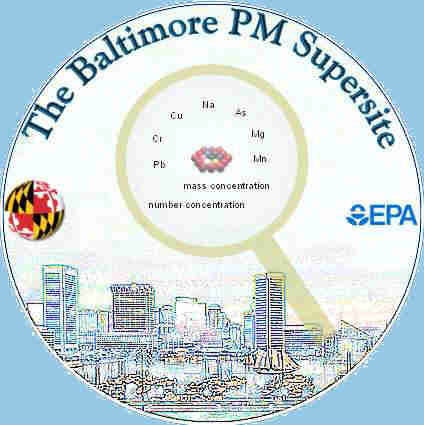 |
| Home |
| The Project |
| Why Baltimore |
| P.I.s |
| Science Team |
| SEAS |
| Lidar Data |
| MET Data |
| Sampling Sites |
| Publications -BSS |
| SOP |
| Related Links |
| Contacts |
| Picture Archive |
| Restricted area |
Last update
06/24/2002
| Project Summary | Hypotheses and Objectives | Project (pdf) |
| Project Summary |
Research Category: Particulate Matter Supersites Program Sorting Code: 99-NCERQA-X1
BALTIMORE SUPERSITE: HIGHLY TIME AND SIZE RESOLVED CONCENTRATIONS OF URBAN PM2.5 AND ITS CONSTITUENTS FOR RESOLUTION OF SOURCES AND IMMUNE RESPONSES
REVISION 1, December 15, 1999
Investigators: J. M. Ondov, Department of Chemistry and Biochemistry, University of Maryland, College Park, MD; T. J. Buckley, School of Hygiene and Public Health, Johns-Hopkins University, Baltimore, MD; P. K. Hopke, Clarkson University, Potsdam, NY; M. B. Parlange, Johns-Hopkins University, Baltimore, MD; W. F. Rogge, Department of Civil and Environmental Engineering, Florida International University, Miami, Florida; K. S. Squibb, Department of Pathology, University of Maryland at Baltimore; and A. S. Wexler, University of Delaware, Newark, DE
Project Period: January 1, 2000 to December 31, 2003
Project Cost: $3,400,000
PROJECT SUMMARY
We propose to conduct a Supersite project in Baltimore to provide an extended, highly time, size, and compositionally resolved data set, including an indicator of cardiopulmonary response in support of testing hypotheses relating to source attribution and health effects of PM. Such information is needed to support development of State Implementation Plans and the setting of National Ambient Air Quality Standards. Specific hypotheses involve investigations of the toxicity of aerosol components as affected by age, industrial vs urban character, and seasonal differences in source terms and atmospheric chemistry. The toxicological metrics chosen, i.e., cytokine and reactive oxygen species (ROS) assays, will be used in correlations with PM metrics, in much the same manner as EPA‰s Integrated Air Cancer Program used mutagenicity assays to apportion ambient PM mutagenicity among air pollution sources. The project will encompass hourly resolved cytokine/ROS assays of PM2.5 as a metric of toxic response; along with similarly time-resolved measurements of PM mass, number vs size distribution, light-scattering coefficient; PM sulfate, nitrate, organic carbon, and elemental carbon using commercial continuous and semi-continuous monitors. In addition, three important new instruments will be fielded: UMCP‰s semi-continuous monitor for quantitatively determining aerosol metals and trace elements; UDE‰s third generation single particle mass-spectrometric analysis system (RSMS III) for continuous size and semi-quantitative determination of individual aerosol particle constituents, from 10 nm to 2.5 µm; and JHU‰s advanced 3 wavelength LIDAR for three dimensional mapping of Baltimore‰s wind fields and aerosol concentrations, including plumes from discrete sources. Traditional 24-hr collections for FRM mass and selected aerosol constituents will provide the link with PM network data. Extensive exploratory organic compound analyses will be performed to reveal the presence of potentially useful tracer species for receptor modeling, and identities and concentrations of potentially toxic PM organic constituents, especially, water soluble polar organic compounds which might contribute to cardiopulmonary-related responses. Gram quantities of PM2.5 will be collected weekly and archived for subsequent use by the research community.
The Highly-time (hourly and subhourly) size, and species resolved composition metrics will permit resolution of their contributions by sources, thus, providing the link between the health effects metric and sources. Source allocations will be reinforced by inclusion of the standard meteorological data in the multivariate analyses and 3-dimensional wind field and particle concentration maps. Plume width and, thus, time of influence on a fixed site increases with increasing distance from the source. Thus, with highly time-resolved pollutant metrics local (even individual), more distant, and regional source contributions will likely be readily resolved into different factors by multilinear regression and advanced factor analysis techniques. The 3-D maps will powerfully and visually document the movement of particles from the sources to the receptor, and ultimately improve our understanding of atmospheric stability and seasonal-mesoscale flow patterns in driving aerosol fields over Baltimore city. Note that Baltimore, like most of the large northeastern deepwater port cities, experiences highly complicated local flow patterns which make source-based modeling extremely difficult.
Time-resolved rotating drum impactors (RDI) will be used to separate fresh accumulation aerosol from nearby sources from aged and cloud processed aerosol, and from tailing coarse particle fractions. The spectra determined from RDI measurements will be used to confirm plume ‹hitsŠ and as a calibration reference for single particle measurements. Cytokine and ROS assays on selected RDI samples will be performed to investigate differences in aerosol age. Mulitvariate calibration models will be used to statistically interpret and interrelate data developed by the variety of new and established techniques. Professor Hopke will utilize his considerable experience in both aerosol measurements and advanced data analysis methods (MLR, PLS, and back propagation neural networks), to provide these critical data analyses.
The equipment will be installed in trailers and deployed to a primary urban site, an industrially influenced urban residential site, and community sites, in support of hypotheses suggested above. Measurements will be made continuously over a 12 month period and will encompass 45-day intensive campaigns to be conducted in summer and winter in South Baltimore to test hypotheses regarding effects of industrial influence and source resolving power of our measurement strategy.
The influence of emissions from source regions at various distances, the variety and severity of local sources, the rich regional and interpretive contexts provided by the IMPROVE site at the Shenandoah National Park, the NARSTO upper air station at Ft. Meade, and abundance of prior regional source attribution studies make Baltimore an excellent location for the proposed measurements and hypothesis testing. Given the severity of diverse sources in close proximity to densely populated areas combined with the complex wind fields, the Baltimore community of scientists and regulators desperately needs the extensive, array of high-quality data which we propose to develop.
Supplemental Keywords: Receptor modeling, aerosol particles, trace elements